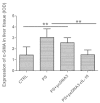Hydrodynamics-based transfection of rat interleukin-10 gene attenuates porcine serum-induced liver fibrosis in rats by inhibiting the activation of hepatic stellate cells
- PMID: 24993843
- PMCID: PMC4121348
- DOI: 10.3892/ijmm.2014.1831
Hydrodynamics-based transfection of rat interleukin-10 gene attenuates porcine serum-induced liver fibrosis in rats by inhibiting the activation of hepatic stellate cells
Abstract
Liver fibrosis is the common pathological outcome for the majority of chronic liver diseases. Interleukin-10 (IL-10) is a cytokine that downregulates proinflammatory responses and has a modulatory effect on liver fibrogenesis. However, little is known regarding the effect of rat interleukin‑10 (rIL‑10) gene by hydrodynamics-based transfection (HBT) on liver fibrosis in rats. The aim of this study was to investigate the effect of the rIL-10 gene by HBT on the progression of liver fibrosis induced by porcine serum (PS) in rats and explore its possible mechanism. Plasmid‑expressing rIL-10 was transferred into rats by HBT and immunohistochemistry and RT-PCR were used to detect the major organ expressing rIL-10. Liver fibrosis was induced in rats by intraperitoneal administration of PS for 8 weeks. Plasmid pcDNA3-rIL-10 solution was administered weekly by HBT starting at the 5th week. Liver function and hepatic histology were examined. The possible molecular mechanisms of rIL-10 gene therapy were assessed in liver tissue and hepatic stellate cells (HSCs) co-cultured with BRL cells (a hepatocyte line) in vitro. The results showed rIL-10 expression occurred mainly in the liver following rIL-10 gene transfer by HBT. Maintaining a stable expression of rIL-10 in serum was assessed by repeated administration. The rIL-10 gene treatment attenuated liver inflammation and fibrosis in PS-induced fibrotic rats, reduced the deposition of collagen and the expression of α-smooth muscle actin (α-SMA) in fibrotic rats. The in vitro experiment showed that the expression of a-SMA and procollagen type I in HSCs co-cultured with the BRL‑transfected rIL-10 gene were significantly decreased. These findings indicate that rIL-10 gene therapy by HBT attenuates PS-induced liver fibrosis in rats and that its mechanism is associated with rIL-10 inhibiting the activation of HSCs and promoting the degeneration of collagen.
Figures










Similar articles
-
Interleukin-10 gene modification attenuates hepatocyte activation of rat hepatic stellate cells in vitro.Mol Med Rep. 2013 Feb;7(2):371-8. doi: 10.3892/mmr.2012.1228. Epub 2012 Dec 11. Mol Med Rep. 2013. PMID: 23232951
-
Interleukin-10 induces senescence of activated hepatic stellate cells via STAT3-p53 pathway to attenuate liver fibrosis.Cell Signal. 2020 Feb;66:109445. doi: 10.1016/j.cellsig.2019.109445. Epub 2019 Nov 12. Cell Signal. 2020. PMID: 31730896
-
Expression of angiotensinogen during hepatic fibrogenesis and its effect on hepatic stellate cells.Med Sci Monit. 2011 Sep;17(9):BR248-56. doi: 10.12659/msm.881928. Med Sci Monit. 2011. PMID: 21873937 Free PMC article.
-
Augmenter of Liver Regeneration Gene Therapy Using a Novel Minicircle DNA Vector Alleviates Liver Fibrosis in Rats.Hum Gene Ther. 2016 Nov;27(11):880-891. doi: 10.1089/hum.2016.006. Epub 2016 May 2. Hum Gene Ther. 2016. PMID: 27136973
-
Reversibility of liver fibrosis.Ann Hepatol. 2009 Oct-Dec;8(4):283-91. Ann Hepatol. 2009. PMID: 20009126 Review.
Cited by
-
11β‑hydroxysteroid dehydrogenase‑1 is associated with the activation of hepatic stellate cells in the development of hepatic fibrosis.Mol Med Rep. 2020 Oct;22(4):3191-3200. doi: 10.3892/mmr.2020.11423. Epub 2020 Aug 7. Mol Med Rep. 2020. PMID: 32945429 Free PMC article.
-
The Immunoregulatory and Regenerative Potential of Activated Human Stem Cell Secretome Mitigates Acute-on-Chronic Liver Failure in a Rat Model.Int J Mol Sci. 2024 Feb 8;25(4):2073. doi: 10.3390/ijms25042073. Int J Mol Sci. 2024. PMID: 38396750 Free PMC article.
-
Antifibrotic Effect of Selenium-Containing Nanoparticles on a Model of TAA-Induced Liver Fibrosis.Cells. 2023 Nov 28;12(23):2723. doi: 10.3390/cells12232723. Cells. 2023. PMID: 38067151 Free PMC article.
-
Silencing p53 inhibits interleukin 10-induced activated hepatic stellate cell senescence and fibrotic degradation in vivo.Exp Biol Med (Maywood). 2021 Feb;246(4):447-458. doi: 10.1177/1535370220960391. Epub 2020 Oct 7. Exp Biol Med (Maywood). 2021. PMID: 33028080 Free PMC article.
-
Ongoing involvers and promising therapeutic targets of hepatic fibrosis: The hepatic immune microenvironment.Front Immunol. 2023 Feb 16;14:1131588. doi: 10.3389/fimmu.2023.1131588. eCollection 2023. Front Immunol. 2023. PMID: 36875101 Free PMC article. Review.
References
-
- Reeves HL, Friedman SL. Activation of hepatic stellate cells - a key issue in liver fibrosis. Front Biosci. 2002;7:808–826. - PubMed
-
- Schuppan D, Pinzani M. Anti-fibrotic therapy: lost in translation? J Hepatol. 2012;56(Suppl 1):S66–S74. - PubMed
-
- Friedman SL. Molecular regulation of hepatic fibrosis, an integrated cellular response to tissue injury. J Biol Chem. 2000;275:2247–2250. - PubMed
-
- Hung KS, Lee TH, Chou WY, et al. Interleukin-10 gene therapy reverses thioacetamide-induced liver fibrosis in mice. Biochem Biophys Res Commun. 2005;336:324–331. - PubMed
Publication types
MeSH terms
Substances
LinkOut - more resources
Full Text Sources
Other Literature Sources
Medical

